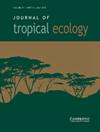亚湿润热带森林中鸟类和哺乳动物种子传播网络对人类引起的森林边缘的反应
IF 1
4区 环境科学与生态学
Q4 ECOLOGY
引用次数: 3
摘要
热带森林等物种丰富的生态系统极易受到人为破坏。大多数热带植物依靠动物来传播种子。然而,互惠相互作用的模式很少被探索,种子传播网络在非洲的研究仍然很少。在这里,我们研究了坎坦赫斯国家公园(几内亚比绍)内西非半湿润热带森林的森林边缘(FE)种子传播网络与成熟森林(MF)的差异。此外,我们还探讨了物种在网络中的作用。MF有更高的水果可得性,更多的水果访问者和植物-水果相互作用。不同栖息地之间的网络结构非常相似,显示出冗余的迹象,并且对物种灭绝具有一定的稳健性。有限元更具嵌套性、模块化和专门化,而MF具有更高的连通性、相互作用均匀性和抗消光鲁棒性。大多数物种为多面手,但大型食果动物在MF中占主导地位。FE表现出更高的脆弱性,主要是树木的损失。树是保持两个网络结构的关键。因此,大型食果动物和作为网络连接器的果树物种应成为这些森林积极保护管理的重点。只有这些物种的生存种群才能确保种子传播网络的良好表现,促进生态系统的自然更新。本文章由计算机程序翻译,如有差异,请以英文原文为准。
Response of avian and mammal seed dispersal networks to human-induced forest edges in a sub-humid tropical forest
Species-rich ecosystems as tropical forests are extremely vulnerable to anthropogenic destruction. Most tropical plant species rely on animals to disperse their seeds. However, patterns of mutualistic interactions have rarely been explored, and seed dispersal networks are still poorly studied in Africa. Here, we examine how forest edges’ (FE) seed dispersal networks differ from the mature forest (MF) at a West African sub-humid tropical forest within the National Park of Cantanhez (Guinea-Bissau). Additionally, we explore species’ roles within the network. MF had higher fruit availability, more frugivore visitors, and plant–frugivore interactions. Network structure was quite similar between habitats, showing signs of redundancy, and some robustness to species’ extinction. FE was more nested, modular, and specialized, whereas MF had higher connectance, interaction evenness, and robustness to extinction. Most species were generalists, but large-bodied frugivores prevailed at MF. FE showed a higher vulnerability, mostly to the loss of trees. Trees are key, keeping the structure of both networks. Large-bodied frugivores and fruiting-tree species that work as network connectors should thus be the focus of active conservation management in these forests. Only viable populations of these species will ensure a good performance of the seed dispersal network, promoting the natural regeneration of the ecosystem.
求助全文
通过发布文献求助,成功后即可免费获取论文全文。
去求助
来源期刊

Journal of Tropical Ecology
环境科学-生态学
CiteScore
2.10
自引率
0.00%
发文量
44
审稿时长
18-36 weeks
期刊介绍:
Journal of Tropical Ecology aims to address topics of general relevance and significance to tropical ecology. This includes sub-disciplines of ecology, such as conservation biology, evolutionary ecology, marine ecology, microbial ecology, molecular ecology, quantitative ecology, etc. Studies in the field of tropical medicine, specifically where it involves ecological surroundings (e.g., zoonotic or vector-borne disease ecology), are also suitable. We also welcome methods papers, provided that the techniques are well-described and are of broad general utility.
Please keep in mind that studies focused on specific geographic regions or on particular taxa will be better suited to more specialist journals. In order to help the editors make their decision, in your cover letter please address the specific hypothesis your study addresses, and how the results will interest the broad field of tropical ecology. While we will consider purely descriptive studies of outstanding general interest, the case for them should be made in the cover letter.
 求助内容:
求助内容: 应助结果提醒方式:
应助结果提醒方式:


